Question:
Nature–nurture debate
Some human characteristics are entirely the consequence of our genes, such as our eye colour. Others are entirely the consequence of our environment, for example, the languages that we speak. A third group of characteristics are partly due to genetic factors (nature) and are partly acquired from our experiences (nurture); intelligence is an example of this. There have been many debates about the relative importance of nature and nurture. Consider the examples below. Is each one due entirely to nature or nurture, or are any due to a combination. How could the relative importance of nature and nurture be investigated?

▶️Answer/Explanation
Ans: • Skin colour is mainly genetic but light skins become darker on exposure to sunlight containing UV radiation.
• Hair colour is normally genetic but it is possible to dye hair a different colour.
• Sickle–cell anemia is genetically determined.
• Tattoos are due to environment, not genes.
• Ear piercing is also environmental/due to nurture.
• Hair length is influenced by genes with naturally longer hair in some people but it is also influenced by nutrition and cutting during hair styling.
Question:
Some varieties of pea plant grow to about two metres tall and others, called dwarf varieties, grow to less than half a metre. Mendel crossed pure-breeding tall and dwarf varieties together to produce F1 hybrids, which were all tall. What can you conclude from this?
▶️Answer/Explanation
Ans: The tall trait is due to a dominant allele and the dwarf trait to a recessive allele; a plant with one of each allele is tall.
Question:
The F1 hybrids were allowed to self-pollinate to produce an F2 generation. Use a Punnett square diagram to explain the reasons for expecting a 3:1 ratio in the F2.
▶️Answer/Explanation
Ans: One side of the square used for male gametes and a side at right angles for female gametes; T for tall allele and t for dwarf allele (shown in a key); one gamete with T and the other with t for both male and female; four genotypes are TT, Tt, tT and tt; all are tall apart from tt.
Question:
There were actually 1064 F2 plants in total, of which 787 were tall and 277 were dwarf.
a) Calculate the ratio of tall to dwarf plants.
▶️Answer/Explanation
Ans: The actual ratio is 2.84 to 1.
b) Explain why the ratio wasn’t precisely 3:1.
▶️Answer/Explanation
Ans: Chance; random fertilization; each F2 pea plant has a 25% chance of being dwarf and 75% chance of being tall; unlikely that exactly 25% of F2 will actually be dwarf/75% be tall; as with tossing a coin and not getting 50% heads.
Question:
Mendel allowed the F2 generation to self-pollinate. He found that seed collected from self-pollinated dwarf plants produced only dwarf progeny. He collected seeds separately from each of
100 tall F2 plants. He grew the progeny from each of the 100 plants separately. Progeny from 28 of the F2 plants were all tall and from the other 72 included both tall and dwarf plants.
a) Explain these results using the word homozygous if two of the same allele are present and heterozygous if there are two different alleles.
▶️Answer/Explanation
Ans: The 28 plants that only gave tall offspring were homozygous; TT; so all offspring produced by self-pollinating them inherited dominant alleles and were therefore tall; the 72 plants that gave both tall and dwarf offspring were heterozygous; Tt; so when they were self-pollinated they could produce offspring that were dwarf/tt; 25% expected to be dwarf and 75% tall.
b) Calculate the expected percentage of homozygous and heterozygous tall pea plants in the F2 generation.
▶️Answer/Explanation
Ans: 66.6% heterozygous; 33.3% homozygous.
Question:
In humans the allele for brown eyes is dominant over the allele for blue eyes.
a) Can two blue-eyed parents have brown-eyed children?
▶️Answer/Explanation
Ans: Not possible if the allele for blue eyes is due to recessive allele as blue-eyed parents do not have an allele for brown eyes.
b) Can two brown-eyed parents produce a blue-eyed child?
▶️Answer/Explanation
Ans: Possible if both parents have one dominant allele for brown eyes and one recessive allele for blue eyes; 25% chance of a blue-eyed child.
Question:
The Holstein breed of cattle is widely used for milk production. In order to produce milk, each cow must have a calf every year. Holsteins have a black head and black coat with white patches.
Hereford cattle are reared for beef. They have an all-white head and a red coat with no white patches. Many Holstein cattle are artificially inseminated with semen from Hereford bulls. The progeny all have a white head, a black coat and no white patches. Discuss the possible outcome if these Holstein-Hereford crosses were bred together.

▶️Answer/Explanation
Ans: White head due to a dominant allele so 3:1 ratio of white to coloured head; the expected ratio for coat colour is 3 black: 1 red; 3 no white patches: 1 with white patches; all combinations of these traits are possible assuming that the three genes are unlinked; chance of offspring with a red coat and white patches plus a coloured head is 1 in 64.
Question:
Welsh Mountain sheep can have black or white coats. If pure-breeding black and white sheep are mated together, the F1 progeny all have black coats while they are lambs, but the coat gradually lightens to a grey-black colour when the sheep are older. What is the expected outcome if two F1 sheep are bred together? Note that there is also a recessive gene for white coats in sheep, for example, in Bluefaced Leicesters.
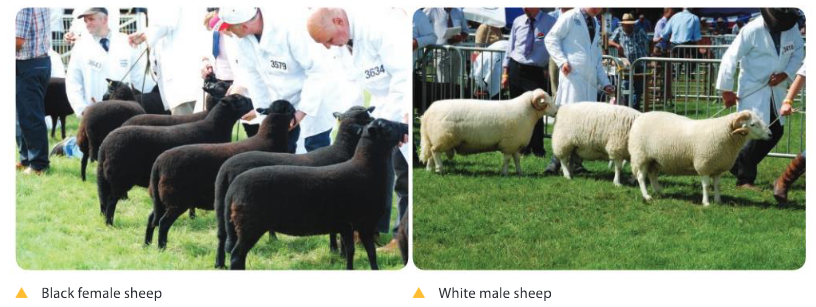
▶️Answer/Explanation
Ans: Three black to one white coated lambs; two out of three lambs’ coats would lighten over time (there is an error in question 3 in the first impression of the book – the gene for white coat in Bluefaced Leicester sheep is dominant, not recessive).
Question:
Genes are made of DNA and are grouped together on long DNA molecules called chromosomes. DNA molecules are very narrow, so chromosomes are only clearly visible when they coil up during mitosis. This is the process that divides a nucleus into two genetically identical nuclei shortly before the cell splits in two. Chromosomes can be spread out and be counted if a cell in mitosis is placed on a microscope slide and pressure is applied to burst it.
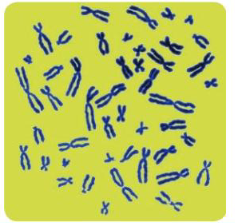
● Do all humans have the same number of chromosomes or is there variation?
▶️Answer/Explanation
Ans: Nearly all humans have 46 chromosomes; a few humans have an extra chromosome so have 47 in total; for example an extra chromosome number 21 in Down syndrome; or an extra sex
chromosome/XXY in Klinefelter’s syndrome; some females have only 45 chromosomes; because they have only one sex chromosome instead of two; Turner’s syndrome.
Question:
Every chromosome has a linear sequence of genes on it, usually with sections of non-coding DNA between one gene and the next. Chromosomes that have the same sequence of genes (and therefore the same structure) can pair up during meiosis. Special stains can be used to show differences in structure between chromosomes. These reveal that body cells normally have two of each type of chromosome, with the same sequence of genes.
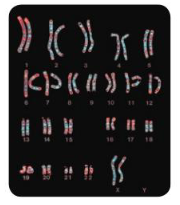
● Do all humans have the same sequence of genes on their chromosomes?
▶️Answer/Explanation
Ans: Yes – humans generally have the same sequence of genes on their chromosomes; this is a fundamental characteristic of a species; allowing chromosomes to pair up in meiosis; in rare cases
part of the sequence of genes on a chromosome is reversed; or a series of genes are moved to a new position; although generally humans have genes in the same sequence there can be differences in the alleles of these genes that are present.
Question:
The pairs of chromosomes that form during meiosis are oriented randomly, so each gamete can receive either one of each pair of chromosomes. A horse roundworm, Parascaris equorum, has two pairs of chromosomes which gives four possible combinations of chromosomes. The yellow fever mosquito, Aedes aegypti, has three pairs and so eight combinations of its chromosomes are possible.
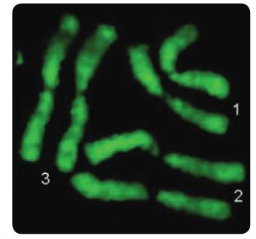
● How many combinations of chromosomes could there be in one human’s gametes?
▶️Answer/Explanation
Ans: There could be 223 combinations; which is over 8 million.
Question:
A gene is a length of DNA with a specific sequence of bases. Alleles of a gene differ in their base sequence. The commonest differences are single nucleotide polymorphisms (SNPs), which affect just one base. SNPs can have major consequences. For example, one base change from adenine to thymine in the hemoglobin gene causes sickle-cell anemia.
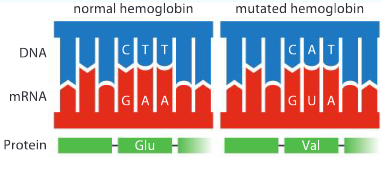
● How many different single nucleotide polymorphisms have been discovered in humans?
▶️Answer/Explanation
Ans: There are huge numbers of SNPs on each of the 23 chromosome types; 1.5 million is a current estimate for the total number of SNPs in the human genome.
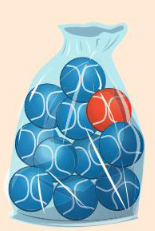
a) Is it more likely that the red mutant allele will spread through the population or be eliminated?
▶️Answer/Explanation
Ans: More likely to be eliminated.
b) The chance of the red mutant allele replacing the blue one can be calculated mathematically. Is the chance greater in small or large populations?
▶️Answer/Explanation
Ans: Greater chance in small populations.
c) How could this activity be modified to simulate beneficial or deleterious mutations?
▶️Answer/Explanation
Ans: Change the proportion of red and blue balls in the bag between generations to simulate natural selection.

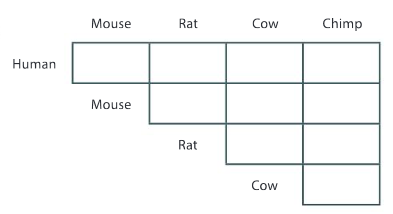
Question:
Count how many differences there are between each pair organisms and use the chart to record the numbers.
▶️Answer/Explanation
Ans: 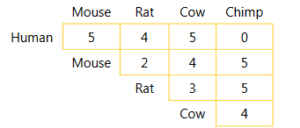
Question:
Which two species show:
a) the smallest amount of genetic variation?
▶️Answer/Explanation
Ans: Chimp and human show the least genetic variation.
b) the second smallest amount of genetic variation?
▶️Answer/Explanation
Ans: Rat and mouse show the second smallest variation.
Question:
Suggest an explanation for the differences in genetic variation between these five species.
▶️Answer/Explanation
Ans: Common ancestors of these five mammals had the same amino acid sequences; differences gradually accumulated; over millions of years; by mutation; and natural selection/genetic drift.
Question:
There is variation in populations.
This variation is due to mutation and sexual reproduction. How does sexual reproduction cause variation in a population?
▶️Answer/Explanation
Ans: Fertilization; genes from two different parents combined when the male and female gamete fuse together; meiosis; only half of the genes/alleles of a parent are passed on to each cell produced by meiosis; random combination of chromosomes/genes/alleles.
Question:
Chances of survival and reproduction are affected by an individual’s characteristics. There are many factors that have an impact on chances of survival and reproduction:
● Some individuals are more successful at competing for food, so they are likely to grow more rapidly and have more resources for reproduction and they are less likely to die during periods of food shortage.
● Some individuals are better at evading predators, for example, by escaping when chased or by effective camoutage.
● Some individuals are more resistant to disease, so they survive during epidemics that kill others.
● Some individuals are more successful at attracting a mate, for example, by their physical appearance, their courtship displays or by fighting their rivals. Can you find real examples of these or other factors?
▶️Answer/Explanation
Ans: There are many possible examples of each of the four types of factor.
Question:
Offspring inherit characteristics from their parents.
Some characteristics are acquired as a result of our environment, but most are due to our genes and can therefore be passed on to offspring.
Does evolution by natural selection happen with characteristics that were acquired as a result of our environment?
▶️Answer/Explanation
Ans: Acquired characteristics cannot be passed on to offspring; so they are not significant in evolution; some patterns of gene expression can be passed on but these are still impermanent and therefore are not as significant as natural selection of heritable variation.
Question:
What is the difference between natural selection and evolution?
One of each of these pairs of statements refers to evolution and the other to natural selection. In each pair, which is which?
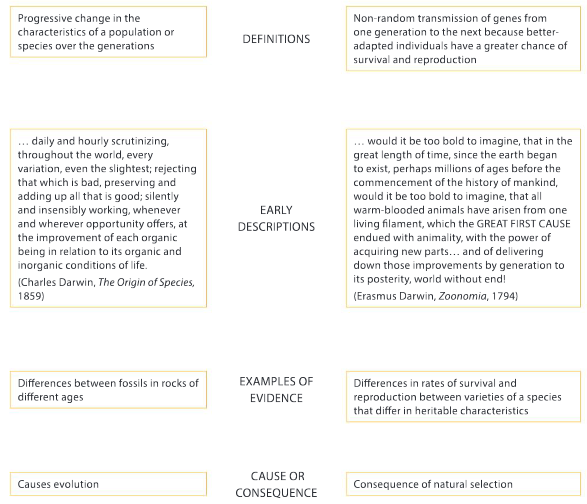
▶️Answer/Explanation
Ans: • Natural selection is:
Non–random transmission of genes……daily and hourly scrutinizing…Differences in rates of survival…Causes evolution
• Evolution is:
Progressive change……would it be too bold to imagine…Differences between fossils Consequence of natural selection
Question:
To which species is the Aptenodytes forsteri (Emperor penguin) most closely related?
▶️Answer/Explanation
Ans: Aptenodytes patagonicus.
Question:
How can we explain the presence of wings even though penguins do not fly?
▶️Answer/Explanation
Ans: Penguins have evolved from flying birds; they have retained wings even though have evolved not to fly; through evolution their wings have become adapted to swimming.
Question:
Fossil evidence suggests that the common ancestor of penguins lived about 70 million years ago. Roughly how often have splits occurred between penguin species since that time?
▶️Answer/Explanation
Ans: Up to six splits between the common ancestor and modern penguins; 70 million years/6 splits; 1 split per 11.7 years on average.
Question:
Penguins vary considerably in size with the largest species in the far south and the smallest species close to the equator. Suggest reasons for penguins evolving to become
a) larger if they migrate southwards
▶️Answer/Explanation
Ans: Reduce the surface area to volume ratio; prevent excessive heat loss; in colder conditions to the south.
b) smaller if they migrate northwards.
▶️Answer/Explanation
Ans: Increase the surface area to volume ratio; allow sufficient heat loss; in warmer conditions to the north; better for the species to have a large population of small penguins than a smaller population of larger ones.
Question:
In several cases, biologists do not all agree whether populations of penguin are separate species or are just varieties of one species. This is quite a common problem when animals and plants are being classified. Darwin used it as evidence in his great book Origin of Species. Explain how the problem of populations that might or might not be separate species can be seen as evidence for evolution by natural selection.
▶️Answer/Explanation
Ans: Species gradually split; as two or more populations become separated; and evolve to become more and more different; by natural selection acting differently on the populations; evolution is gradual so there is no specific point at which the two populations have become two species.
Question:
There is no evidence for new species being created from non-living matter on Earth. There is abundant evidence for existing species splitting to produce new species. This process is called
speciation. What are the most important factors causing speciation to happen frequently on islands?
▶️Answer/Explanation
Ans: On an island a population is usually isolated from other populations of its species; conditions are often different from elsewhere; so natural selection operates differently; so the island
population diverges from the rest of the species and becomes a new species.
Question:
The dodo is a famous example of a species that has been completely annihilated. It inhabited the island of Mauritius. Many island species have died out. This process is called extinction. What are the most important factors causing extinction to be happening frequently on islands at the moment?
▶️Answer/Explanation
Ans: Overexploitation by humans; introduction of alien species that compete with endemic island species; or alien species that predate island endemics; or pathogens/parasites are introduced to which island species do not have immunity.
Question:
What is the latest example of genetic modification in either a crop plant or a farm animal that you can find?
▶️Answer/Explanation
Ans: Answer depends on when the student researches the most recent example of a GMO.
Question:
Can GM crops be legally grown in your area or are they banned?
▶️Answer/Explanation
Ans: Answer depends on the jurisdiction in which the student lives – some countries ban GMOs and others do not.
Question:
Using what you know about gene transfer, evaluate the importance of keeping “natural” and GM organisms separate.
▶️Answer/Explanation
Ans: Most biologists consider it undesirable to allow gene transfer between GMOs and natural populations; gene transfer within plant and animal species can occur by cross-breeding; so this should be avoided; for example GM salmon cross-breeding with wild salmon; gene transfer in bacteria happens very readily; for example with plasmids; so GM bacteria should be isolated to
prevent it.
Question:
Would a GMO be favoured by natural selection over a non-genetically modified one? What would this depend on?
▶️Answer/Explanation
Ans: GMO would probably not be favoured; because the extra genes/traits are ones useful to humans and not to the organism; for example salmon that grow to a larger size are unlikely to have an advantage over wild salmon; because wild the size of wild salmon is due to natural selection over a long period; whether GMOs are favoured depends on the transferred gene and the conditions experienced by the GMOs and non–GMOs.
Question:
What is the advantage of cloning an adult animal rather than an embryo?
▶️Answer/Explanation
Ans: The traits of the adult are known; adults with the most desirable traits can be selected for cloning.
Question:
Is the natural process of human embryos splitting to produce identical twins a form of cloning?
▶️Answer/Explanation
Ans: Biologically/genetically it is no different from other natural methods of cloning; but identical twins are unlikely to welcome being regarded as clones.
Question:
What are the ethical objections to cloning humans?
▶️Answer/Explanation
Ans: Individuals resulting from adult cloning have a high risk of health problems/shortened life expectancy; cloning humans is unnatural/is ‘playing God’; only wealthy individuals are likely to be able to afford it; the Earth is overpopulated so each person should only be allowed to live once and not be given another life through cloning; obtaining embryonic stem cells requires the destruction of embryos that can then not be used for IVF.
Summative assessment
Late blight disease
Question:
In the 1840s, many people in Ireland had become dependent on potatoes for food. When crops of potatoes failed year after year because of the disease “late blight”, the consequences were immense—one in eight Irish people died of starvation and many more emigrated to America. The destruction of entire potato crops was the consequence of a lack of genetic diversity. Explain how there was so little genetic diversity in potato crops grown in Ireland at that time.
▶️Answer/Explanation
Ans: Potatoes reproduce asexually; one tuber planted results in many genetically identical tubers harvested; a variety of potatoes is a clone; farmers preferred the same varieties so all planted them.
Question:
Cultivated varieties of potatoes have been developed from wild species in South America. The process took hundreds or maybe even thousands of years. Explain how a cultivated variety of plant can be developed from a wild species and reasons for it taking such a long time.
▶️Answer/Explanation
Ans: Farmers select the best potato plants/tubers; and grow the next year’s crop from them; mutations give variation; much less variation if sexual reproduction does not occur; slower change/evolution with less genetic variety.
Question:
Late blight is caused by the micro-organism Phytophthora infestans. In wild potato species, many plants are resistant to this micro-organism and do not suffer from late blight. Explain how resistance to Phytophthora infestans could develop in populations of wild potato.
▶️Answer/Explanation
Ans: Mutation to give genes for blight resistance; potato plants with blight resistance survive when there is infection/plants without the blight resistance gene die; plants with the resistance gene pass it on to the next generation of plants.
Question:
Some cultivated varieties of potato have been produced that are resistant to Phytophthora infestans, but this resistance often only works for a few years and then the variety starts to suffer from late blight. Suggest reasons for a cultivated potato variety that was resistant becoming susceptible to late blight.
▶️Answer/Explanation
Ans: Mutations in the blight fungus; genes in blight fungus allow resistance in potato plants to be overcome; sexual reproduction of fungus allows spread of genes for overcoming blight resistance; natural selection for overcoming resistance/evolution in the blight fungus.
Question:
In the past, resistant potato varieties were produced by cross-breeding cultivated varieties with wild species that contained a resistance gene. Scientific and technological innovations have made it possible to transfer individual genes for resistance from wild species such as Solanum venturii to cultivated varieties of potato. Suggest advantages of this new method for developing resistant potato varieties.
▶️Answer/Explanation
Ans: Much less haphazard/less chance involved; chosen genes can be transferred and no other; much quicker; genes can be transferred from another species/between species that do not cross–breed; good combinations of genes in a potato variety are not broken up by sexual reproduction.
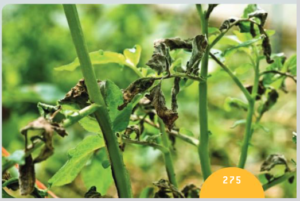
Some leaves on this potato plant are already dying due to late blight and soon the disease will spread to other leaves and stems and also to the growing tubers.
Cloning potatoes
Question:
When an improved new variety of potato has been produced, millions of tubers of this variety are needed for farmers to plant. If one tuber is planted and allowed to clone naturally, up to 20 tubers may be produced by the end of the growing season. Explain the need for a more rapid method of cloning a new variety of potato.
▶️Answer/Explanation
Ans: If the increase per year is only twentyfold it will take many years to produce enough tubers of a variety for farmers to use; no profits are made from breeding a new potato variety until it can be sold to farmers; a new variety could become blight– susceptible quicker if many years have elapsed before it is released to farmers.
Question:
Choose an artificial method of cloning potatoes—you could use cuttings, portions of a tuber with a bud, or small pieces of tissue from inside a bud (micropropagation). Think of an innovation that might improve this method of cloning; for example, rooting hormone might encourage buds to develop roots more rapidly.
a) Formulate a testable hypothesis, based on your innovation.
▶️Answer/Explanation
Ans: Award marks on a scale from 0 marks if the statement is not a relevant hypothesis, or is untestable or is utterly implausible, up to 3 marks for a clear, testable hypothesis based on a chosen innovation.
b) Explain the scientific reasoning for your innovation.
▶️Answer/Explanation
Ans: Award marks on a scale from 0 marks for no relevant scientific understanding to 3 marks for a clear explanation of the hypothesis based on scientific understanding.
c) Design an experiment to test your hypothesis.
▶️Answer/Explanation
Ans: Award marks on a scale from 0 marks for an experimental design without merit to 9 marks for an exemplary design with full experimental details including independent, dependent and control variables, numbers of repeats and both ethical and safety considerations.
Analyzing potato cloning methods
8. a) Present the data that you have collected in your experiment, using suitable tables and charts.
▶️Answer/Explanation
Ans: All columns and rows on the results table labelled; results recorded in individual cells on the results table to an appropriate degree of precision; appropriate choice of chart and assignment of axes; accurate plotting of points/bars on the chart; chart displays the data effectively so the salient trends are clear.
b) Interpret the data and explain your results using scientific reasoning.
▶️Answer/Explanation
Ans: Award marks on a scale from 0 marks for an entirely inadequate interpretation and explanation of the results to 5 marks for a convincing and comprehensive interpretation and explanation based on scientific reasoning.
c) Evaluate the validity of your method and your hypothesis.
▶️Answer/Explanation
Ans: Clear statement that the method did/did not test the hypothesis effectively; clear account of any uncertainties remaining; clear statement that the results did/did not support the hypothesis.
d) Suggest improvements or extensions to your experiment.
▶️Answer/Explanation
Ans: Valid improvement/extension to the experiment; another valid improvement/extension to the experiment.
Genetically modified potatoes
Late blight is a troublesome disease of potatoes. The disease spreads from July onward and in some years farmers have to spray potato crops with fungicide as many as 15 times to prevent the disease. In 2014, it was announced that a new blight-resistant GM potato variety had been produced by biologists at the Sainsbury Laboratory in England. The gene Rpi-vnt1.1 from the wild species Solanum venturii had been transferred to the potato variety Desiree. See http://rstb.royalsocietypublishing.org/content/369/1639/20130087
Field trials over three years showed a high level of resistance to late blight in the genetically modified Desiree plants, with leaves of the unmodified Desiree plants almost completely destroyed each year. The yield of the GM potato crop was twice as high as the non-GM. Regulations prevented the biologists from tasting the GM Desiree potatoes, but there is no known mechanism for the taste being altered by the presence of the new gene.
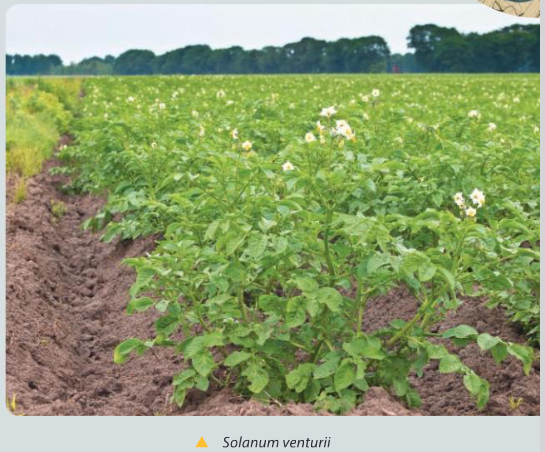
Over 400 R genes conferring blight resistance are known in potatoes, but a similarly large number of genes that overcome resistance have been discovered in Phytophthora infestans. If a stack of R genes were transferred to potatoes they should make a potato variety resistant to late blight for many years.
Because the European Union is unlikely to give approval for growing GM crops for human consumption, the biologists granted a license for using the GM technology that they had developed to an American company. Professor Jones who led the research team has been quoted as saying “I think it is unfortunate that American farmers are going to benefit from the fruits of European taxpayers’ funded work way before the Europeans”.
Question:
Write an evaluation of genetic modification of potatoes to make them blight resistant. Consider both arguments for and against, ending with an overall assessment of whether you think they should be banned as in the European Union or approved as in the United States. Try to use scientific language effectively in your evaluation.
▶️Answer/Explanation
Ans: Award marks on a scale from 0 for an account that is irrelevant, incomprehensible or not based on a scientific understanding of genetic modification to 15 marks for an exemplary account using scientific language, which presents in a balanced way all the important arguments for and against genetic modification, with an overall judgment of whether it should be banned or not.
